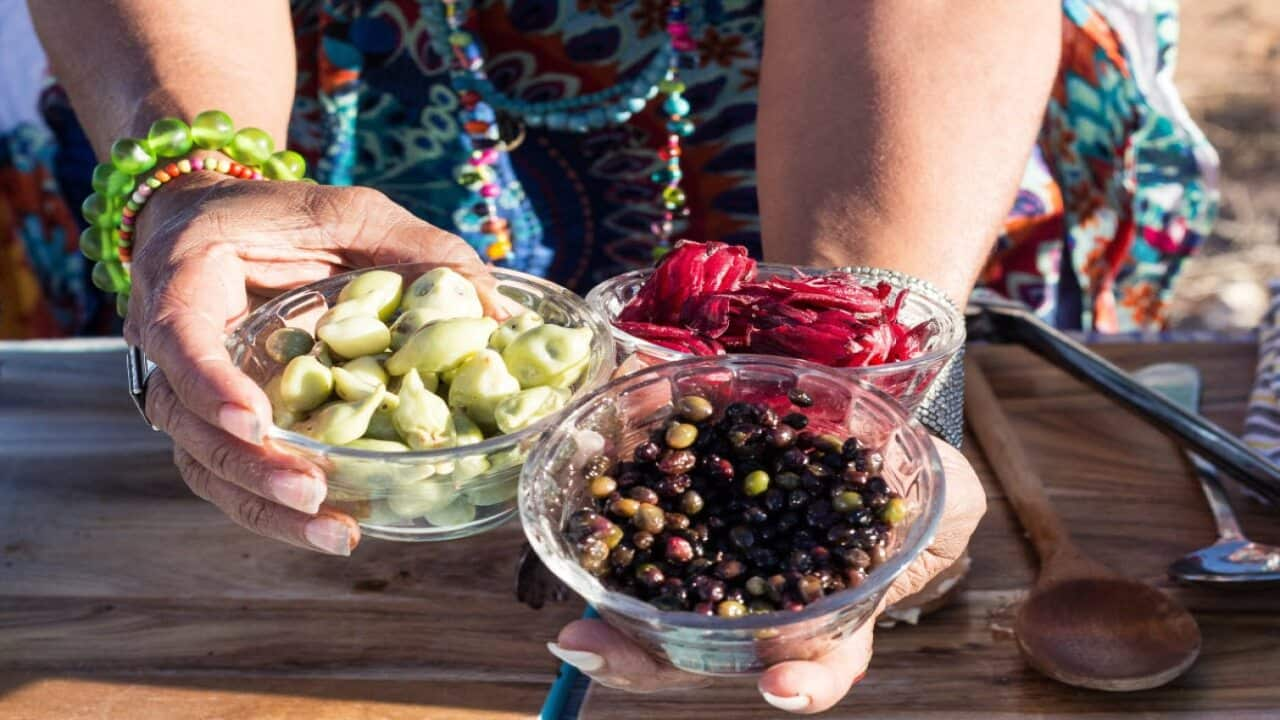In the Apsley Strait that runs between the the two main islands, Melville and Bathust, a row of black-lip oyster cages, tethered together by rope, float offshore between the reefs and sandbanks.
It's a new way of harvesting an island delicacy that grows wild on rocks fringing the Tiwi Islands, north of Darwin in the Northern Territory.
"I've been growing up eating them oysters, all the bush food from the sea, oysters, turtle, dugong, crab, lots of things in the sea," Tiwi man Les Morris Ullungurra told NITV News.

Mr Ullungurra's clan group, the Mantiyupwi clan, are the Traditional Owners of the land and sea across the south east of Bathurst Island, the south of Melville Island and the Vernon Islands. Credit: NITV / Laetitia Lemke
Tiwi man Urban Kerinaiua, who is part of the Mantiyupi clan, works to maintain the oyster farm.
"This is how we started for a trial doing the oyster farm because our clan want us to try different things... we've had it going there from last August," Mr Kerinaiua said.
The trial so far has seen more than 140,000 baby oysters placed in spat socks that sit inside the cages.

The tiny black-lip oyster spat is bred in the Darwin Aquaculture Centre, takes around 18 to 24 months to grow to a market size. Credit: NITV / Laetitia Lemke
Twice a fortnight the cages are flipped to air dry and externally cleaned of seaweed and other debris, a way of controlling the accumulation of biofouling organisms.
29-year-old Mr Kerinaiua said the oysters inside have more than doubled in size since they were placed.
"We've seen some growth, probably now the size of my fingernail," he said.

Oyster cages being rotated to dry by Les Morris Ullungurra. Credit: NITV / Laetitia Lemke
Researchers collect spawn from wild oysters, feeding them on a formula of algae until they’re big enough to release.
Leading that research is Evan Needham - the acting program director for aquatic and strategic policy with NT Fisheries at the Darwin Aquaculture Centre - who started working with the Tiwi Island community over a decade ago to develop a world first trial.
"We were actually approached by Traditional Owners on the Tiwi Islands who had some concerns around the food collection of black-lip rock oysters and asked if we could help," Mr Needham told NITV.
"This particular species hadn't been bred before so we had a world first with breeding this oyster and now we're just trying to perfect the techniques to produce commercial quantities of oysters."

Evan Needham at the Darwin Aquaculture Centre on Channel Island. Credit: NITV / Laetitia Lemke
The research has also received Commonwealth Government grants through The Cooperative Research Centre for Developing Northern Australia (CRCNA) and Fisheries Research and Development Corporation (FRDC).
Similar oyster trials have since been expanded to three more Top End communities including Groote Eylandt, South Goulburn Island, and Wadeye.
"I think that having a product that has a provenance that is grow in a remote destination by traditional owners in the Northern Territory is a fabulous story," Mr Needham said.
However, with hopes of taking the black-lip oyster to global markets in the next two years, Mr Needham said more investment is needed before the project wraps in 2026.
"We're hoping in the next year or so that some of these oysters will be out on the market," he said.

Black-lip Rock Oysters are a native species of tropical oyster found throughout the Northern Territory which have never been produced commercially. Credit: NITV / Laetitia Lemke
"For us to get that black-lip oyster is good for our people," Mr Kerinaiua said.
"I hope it will grow and we can send it to Darwin and all over the globe and they can have a taste of an oyster that grows on our water."













